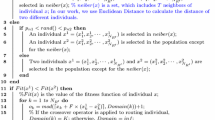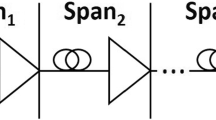Abstract
Radio-over-Fiber (RoF)-based cellular backhauling consitutes a promising solution to realize a cost-effective evolution of radio access networks towards higher radio-cells densification. In this paper, we recall the main characteristics of an innovative cellular backhauling all-optical network architecture called Generic Radio-over-Fiber Access Network (GeRoFAN) aiming to federate 4G system radio cells. However, the transport of multiple radio channels over an analog RoF link is subject to optical crosstalk and intermodulation distortions causing a decrease of the wireless system capacity. Supported by an analytical modeling of the relevant optical transmission limitations, we propose an impairment-aware radio cellular backhauling strategy for GeRoFAN able to maximize the radio cellular capacity while achieving an efficient use of optical resources. This optimization problem is solved through Pareto-based Genetic Optimization (PaGeO), a multi-objective meta-heuristic based on evolutionary algorithms and exploiting the concept of Pareto front. Numerical results indicate that PaGeO, applied to LTE cellular system, outperforms alternative backhauling strategies by achieving an excellent compromise between preserving the radio capacity of the system and the number of required optical channels. We also highlight how the optimal backhauling strategy calculated using PaGeO enables GeRoFAN to take full benefit from overlaying several radio channels per cell site.

















Similar content being viewed by others
References
Aleksić, S. (2013). Optically transparent integrated metro-access network. Telecommunication Systems, 52(3), 1505–1515.
Yang, Y. (2010). Multichannel digitized rf-over-fiber transmission based on bandpass sampling and FPGA. IEEE Transactions on Microwave Theory and Techniques, 58(11), 3181– 3188.
Al-Raweshidy, H., & Komaki, S. (2002). Radio-over-fiber technologies for mobile communications networks. Norwood: Artech House Inc.
Attard, J. C., & Mitchell, J. E. (2006). Optical network architectures for dynamic reconfiguration of full duplex, multi-wavelength, radio-over-fiber. OSA Journal of Optical Networking, 5(6), 435–444.
Lin, W.-P. (2005). A robust fiber-radio architecture for wavelength-division-multiplexing ring-access networks. IEEE Journal of Lightwave Technology, 23(9), 2610–2620.
Wake, D., Nhansah, A., & Gomes, N. J. (2010). Radio-over-fiber link design for next generation wireless systems. IEEE/JLT, 28(16), 2456–2464.
Haddad, A., Gagnaire, M., & Doumith, E. A. (2011). Impairment-aware control plane for next generation radio-over-fiber access networks. In Proceedings of IEEE/IFIP 2nd International Conference Network of the Future (pp. 92–96).
Haddad, A., Doumith, E. A., & Gagnaire, M. (2012). Impairment-aware radio-over-fiber control plane for LTE antenna backhauling. In International Conference on Communications (IEEE/ICC 2012), Ottawa.
Li, G. L., Sun, C. K., Pappert, S. A., Chen, W. X., & Yu, P. K. L. (1999). Ultrahigh-speed traveling-wave electroabsorption modulator-design and analysis. IEEE/ Transactions on Microwave Theory and Techniques, 47(7), 1177–1183.
Lee, G.-W., & Han, S.-K. (1999). Linear-dual electro-absorption modulator for analog optical transmission. Microwave and Optical Technology Letters, 22, 369–373.
Niiho, et al. (2006). Transmission performance of multichannel wireless LAN system based on radio-over-fiber techniques. IEEE/Transactions on Microwave Theory and Techniques, 54(2), 980–989.
Tonguz, O. K., & Jung, H. (1996). Personal communications access networks using subcarrier multiplexed optical links. IEEE/JLT, 14(6), 1400–1409.
Desem, C. (1990). Optical interference in subcarrier multiplexed systems with multiple optical carriers. IEEE/Journal on Selected Areas in Communications, 8(7), 1290–1295.
Wan, P., & Conradi, J. (1996). Impact of double rayleigh backscatter noise on digital and analog fiber systems. IEEE/Journal of Lightwave Technology, 14(3), 288–297.
Hui, R., et al. (2002). Subcarrier multiplexing for high speed optical transmission. IEEE/Journal of Lightwave Technology, 20(3), 417–427.
Sui, C., et al. (2010). Impact of electro-absorption modulator integrated laser on MB-OFDM ultra-wideband signals over fiber systems. IEEE/Journal of Lightwave Technology, 28(24), 3548–3555.
Dods, S. D., & Tucker, R. S. (2001). A comparison of the homodyne crosstalk characteristics of optical add-drop multiplexers. IEEE/Journal of Lightwave Technology, 19(12), 1829–1838.
Narayankhedkar, S. K., & Shevgaonkar, R. K. (1999). Nonuniform fiber gratings in optical networks. In Proceedings of the Pacific Rim Conference on Lasers and Electro-Optics (pp. 499–500).
Talbi, E.-G. (2009). Metaheuristics: From design to implementation. New York: Wiley.
Parthombutr, P., Stach, J., & Park, E. (2005). An algorithm for traffic grooming in wdm optical mesh networks with multiple objectives. Telecommunication Systems, 28(3–4), 369–386.
Grosan, C., Abraham, A., & Hassainen, A. (2009). Designing resilient networks using multicriteria metaheuristics. Telecommunication Systems, 40(1–2), 75–88.
Man, K. F., Tang, K. S., & Kwong, S. (2000). Genetic algorithms: Concepts and designs. Hong Kong: Springer.
Fonseca, C. M., & Fleming, P. J. (1993). Genetic algorithm for multiobjective optimization: Formulation, discussion and generalization. In Proceedings of the fifth IEE Colloquium on Genetic Algorithms for Control Systems Engineering.
Babcock, W. (1953). Intermodulation interference in radio systems. Bell Systems Technical Journal, 1, 63–73.
Godlewski, M. et al. (2008). Analytical evaluation of various frequency reuse schemes in cellular OFDMA networks. In Proceedings of the 3rd International Conference on Performance Evaluation Methodologies and Tools, (pp. 32:1–32:10).
Kelif, J. M., & Altman, E. (2010). Impact of macrodiversity on capacity and coverage of cellular network. Telecommunication Systems, 43(1–2), 133–143.
Sesia, S., Toufik, I., & Baker, M. (2009). LTE: The UMTS long-term evolution from theory to practice. New York: Wiley.
Struzak, R. (2001). On spectrum congestion and capacity of radio links. Annals of Operations Research, 107, 339–347.
Rumney, M. (2009). LTE and the evolution to 4G wireless: Design and measurement challenges. Santa Clara: Agilent Technologies.
Chen, et al. (2011). A novel high-isolation rf-soi switch for 2.4 GHz multi-standard applications. Analog Integrated Circuits and Signal Processing, 67(1–2), 143–148.
Author information
Authors and Affiliations
Corresponding author
Rights and permissions
About this article
Cite this article
Haddad, A., Gagnaire, M. Optimized Radio-over-Fiber-based cellular backhauling strategy using genetic algorithms and Pareto fronts. Telecommun Syst 61, 295–310 (2016). https://doi.org/10.1007/s11235-015-0002-0
Published:
Issue Date:
DOI: https://doi.org/10.1007/s11235-015-0002-0




